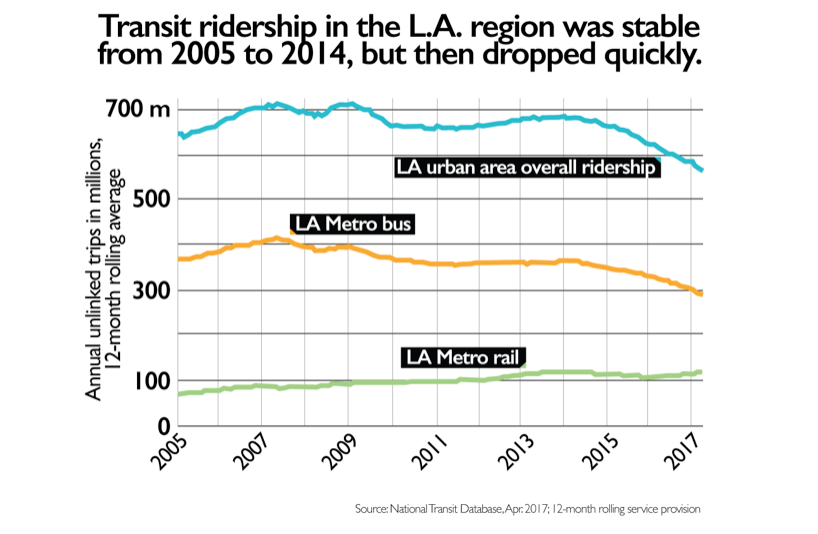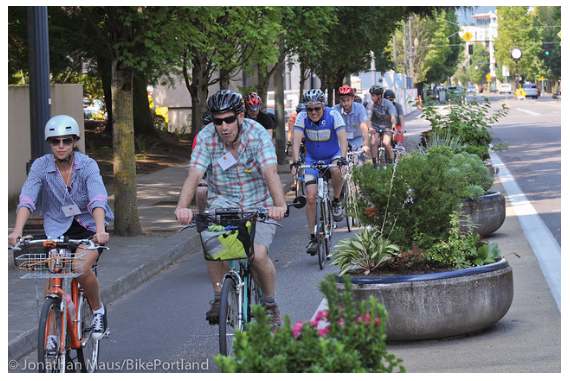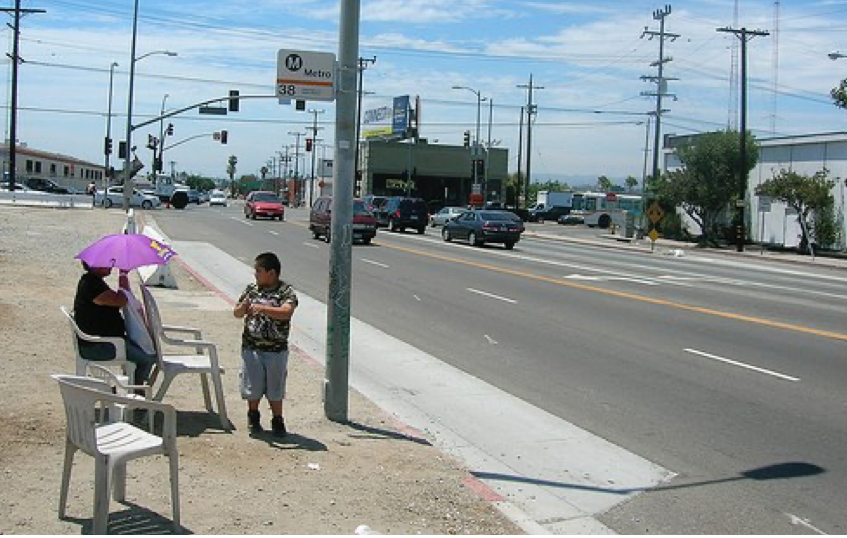CommentsPLANNING WATCH: Our regional transit agency, METRO, has finally realized that years of declining transit ridership require an answer.
Yes, METRO has rapidly expanded its urban rail lines and partnered with the City of Los Angeles to build thousands of new units in “transit oriented developments,” but this has not made a difference. In fact, METRO’s bus ridership has been in steady decline since 2009, and it is now back to 1985 levels. As for rail and subway ridership, it has been flat since 2014.
METRO has responded to this crisis with its Next Gen bus study. It would reduce headways (frequency of buses) to 10 minutes on 29 bus lines. Last week I pointed out that these service upgrades allow these bus lines to qualify as Senate Bill 50’s high quality bus corridors. If this happens, Sacramento’s real estate industry shills will instantly enrich developers and property owners by up-zoning parcels up to a half-mile from each enhanced bus line. At that point all California parcels currently zoned for single-family homes and duplexes could be replaced by fourplex apartments, and in some cases, mid-rise apartment buildings. This construction would be ministerial (i.e., automatic), without any upgrades to infrastructure and public services, monitoring, City Council zone change ordinances, and public notices, hearings, and appeals. The proxies behind this scheme, State Senator Scott Wiener and his mentor, YIMBY California’s Brian Hanlon, have skillfully spread these myths, so if you give them credence, prepare for the worse.
In addition to this hidden flaw in METRO’s Next Gen bus plan, Professor James Moore, director of USC’s Transportation Engineering program, argues that METRO’s proposal to increase transit ridership will only rearrange deck chairs on the Titanic. Why? Because METRO has been decreasing, not expanding, its overall bus supply and service since 2007, when a 1995 Federal Consent decree requiring the agency to steadily expand bus service expired.

Is that it? Is METRO’s only option to increase ridership the reduction of headways on 29 bus lines, while refusing to increase the overall number of busses and surreptitiously aiding a Sacramento-imposed real estate scam? The answer is they could do much more if they chose to.
There are many other available programs that METRO, as well as the City of Los Angeles, could pursue to increase transit ridership. Furthermore, these untapped options are hidden away in METRO’s and the City of LA’s servers and file cabinets as adopted policies and official guidelines. Unfortunately, both government entities have systematically ignored their own documents. If they cracked them open, the following reveals some of the many actions they could take:
Free Transit: The most obvious approach, already rolled in parts of Europe, Kansas City, and Olympia, Washington, is simple. The Los Angeles Unified School District (LAUSD) will also soon adopt it. Make mass transit free. The only expense is a memo to bus drivers telling them to no longer charge fares. In Kansas City the program is only several months old and already showing increased transit ridership, plus forecast economic benefits through increased transportation equity.
The Sins of Commission: A laundry list of sneaky land use proposals would increase the zoning capacity of private parcels up to a half-mile from bus and subway lines. From YIMBY California’s and Senator Scott Wiener’s SB 50’s real estate giveaways in Sacramento to TOC Guidelines and Transit Neighborhood Plans in Los Angeles, these laws shower real estate developers with wealthfare handouts. According to these mavens, granting property owners and developers highly valuable up-zoning without any local review motivates them to build more housing. Regrettably, this legislation is doomed to fail. If these carrots actually result in new housing, it will be expensive units replacing lower priced apartments and homes. Once these pricey units replace existing transit riders with those who own and use personal cars or ride-hailing services for mobility, the game is over.
This explains why Los Angeles, which is in the midst of a transit-adjacent housing boom, has simultaneously experienced declining transit ridership and rising homelessness.
The Sins of Omission. METRO clearly lays out a vast array of programs to increase transit ridership in its adopted Complete Streets and First-Last Mile Strategic Plan policy documents. They include the following, and much more:
- Build bus shelters at all bus stops. This is part of the NextGen plan, but only applies to 29 bus lines. It should apply to all bus lines.
- Expand bicycle infrastructure, which also can be used by e-scooters. This requires buffered bicycle lanes, which are common in other cities, bicycle and scooter parking at stations, and shared bikes-on-demand at all rail stations and busy bus stops.
- Increase pedestrian access to stations. This incorporates new signage, sidewalk repairs, mid-block pedestrian activated cross walks, ADA curb cuts, restriped and raised cross walks, shade tree canopies, sidewalk lighting, and reduced vehicular speeds in pedestrian areas
Many of these public improvements are echoed in similar guidelines carefully prepared, published, and then overlooked by LA’s Department of City Planning.
It’s Mobility Hubs Readers Guide offers the following public improvements to increase transit ridership. When combined with each other, they can transform a transit adjacent area into a Transit Oriented Community.
- Bicycle infrastructure, including bike sharing, lanes, and parking.
- Vehicle connections, including ride sharing, park ‘n ride, pick up and drop-off zones, car sharing, and electric vehicle infrastructure.
- Bus infrastructure, including shelters, phone apps, priority lanes, and station interfaces.
- Information, including wayfinding signs, real time data, and smart phone connectivity.
- Active uses, including services, retail stores, and public space.
- Pedestrian connections, including upgraded sidewalks, streetscape, lighting, safe intersections, and shade tree canopies.
In addition, City Planning’s more detailed and exemplary Complete Streets Design Guide is posted on its website. It includes the following programs, part of a much longer catalog of programs and design features to increase transit ridership:
- Public streetscape, including trees, landscaping, benches, lights, signage, parklets, and trash cans. For those who don’t like to read manuals, they can visit Santa Monica Boulevard in West Hollywood to see this manual in action.
- Outdoor dining.
- Peak hour bus lanes and bus shelters.
- Pedestrian plazas.
- Bicycle share stations and lanes, preferably protected and already common in cities like Portland, Seattle, Chicago, Denver and New York.

Protected bike lane in Portland, Oregon.
- Raised crosswalks, crosswalk markings, decorative pavement materials, and crossing refuge islands.
With so many available policy documents and manuals, it is hard to sympathize with transit agencies and cities, like Los Angeles, that reject so many obvious opportunities to get people out of their cars, often into buses, light rail, and subways. Instead they hide behind the empty claims that they are increasing transit ridership by glad-handing real estate developers (many of whom are political donors).
At best this approach won’t make a difference because real estate developers can more easily flip their properties to pocket some quick, unearned, and barely taxed profits. Upzoning means they no longer need to build apartments to make money.
At worst, though, it will make things worse. Current low income residents, many of whom are transit dependent, will be shoved aside to make way for new, expensive apartment buildings filled with cars and the people who drive them. These new residents might live in transit-adjacent buildings, but because of their high incomes and cars, they will be transit-averse. Transit ridership will continue to slide, street congestion and Green House Gases will rise, and the real remedies will remain hidden way at METRO’s Taj Mahal and LA’s City Hall.
(Dick Platkin is a former Los Angeles city planner who reports on local planning issues for CityWatchLA. He serves on the board of United Neighborhoods of Los Angeles (UN4LA) and is co-chair of the new Greater Fairfax Residents Association. Please send comments and corrections to [email protected].)
-cw
















